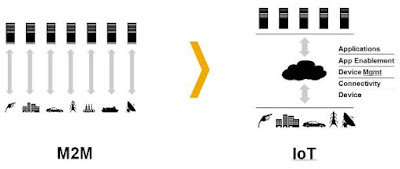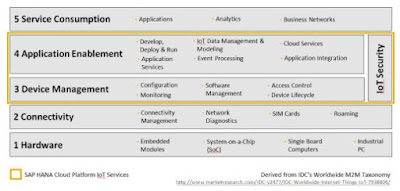With Cloud Computing and the Internet of Things (IoT) we are facing two trends of which each one for itself has the potential to change the whole IT industry. Recently, these two trends are being combined in IoT device clouds enabling businesses to efficiently collect data from the Internet of Things and manage devices that connect things to the Internet.
The advantage of such device clouds over classical Machine-to-Machine (M2M) telemetry solutions is that they connect potentially any kind of device to a consistent, well-managed, centralized storage in the cloud from where any application can uniformly access the data collected from the devices and things respectively. In contrast, classical M2M solutions tended to build vertical silos as they typically connected a specific type of device to a certain application often using proprietary technology.
With today’s announcement of the SAP HANA Cloud Platform for the Internet of Things, SAP now also offers a set of services on top of its cloud platform that extend its capabilities towards a full-fledged device cloud. In a typical IoT technology stack the newly announced capabilities can be found on the device management and application enablement layers (see figure below). So, SAP now perfectly complements its strong IoT capabilities in the areas of big data, analytics, messaging, and business process integration with this new offering. Thereby, SAP’s IoT technology stack becomes one of the most comprehensive stacks that you can get within the industry from one single vendor. Rather than stopping with sensor-to-cloud or sensor-to-insight, SAP covers the whole stack from sensor to action through its deep integration capabilities with business processes and business networks. On the network connectivity layer and the hardware layer that are not covered by SAP technology, SAP can rely on one of the strongest partner eco-systems in the industry.
The advantage of such device clouds over classical Machine-to-Machine (M2M) telemetry solutions is that they connect potentially any kind of device to a consistent, well-managed, centralized storage in the cloud from where any application can uniformly access the data collected from the devices and things respectively. In contrast, classical M2M solutions tended to build vertical silos as they typically connected a specific type of device to a certain application often using proprietary technology.
With today’s announcement of the SAP HANA Cloud Platform for the Internet of Things, SAP now also offers a set of services on top of its cloud platform that extend its capabilities towards a full-fledged device cloud. In a typical IoT technology stack the newly announced capabilities can be found on the device management and application enablement layers (see figure below). So, SAP now perfectly complements its strong IoT capabilities in the areas of big data, analytics, messaging, and business process integration with this new offering. Thereby, SAP’s IoT technology stack becomes one of the most comprehensive stacks that you can get within the industry from one single vendor. Rather than stopping with sensor-to-cloud or sensor-to-insight, SAP covers the whole stack from sensor to action through its deep integration capabilities with business processes and business networks. On the network connectivity layer and the hardware layer that are not covered by SAP technology, SAP can rely on one of the strongest partner eco-systems in the industry.
In addition to the deep vertical coverage of the IoT stack, SAP also has a broad technology portfolio on each layer of the stack. So, SAP customers are not forced into a one-fits-all solution but SAP supports them always with the right technology that best fits the customer’s needs. With various storage technologies, for example, SAP can support scenarios where one single machine produces 10s-100s of Mbytes of data per day and still can analyze this data in (near) real-time with the SAP HANA in-memory technology. At the other end of the spectrum, SAP cost-efficiently supports scenarios with classical relational database systems where a machine, e.g. a vending machine, only sends one text message per day with the current status information on the inventory. The same is true with the various messaging technologies that SAP offers.
Overall, the SAP HANA Cloud Platform for the Internet of Things consists of the industry-leading SAP HANA Platform offering the superfast in-memory database and various database services, the SAP HANA Cloud Platform supporting various programming models, runtime containers, and applications services in a highly flexible, agile, and scalable cloud environment, and the SAP HANA Cloud Integration tools and services for messaging and process & data integration with on premise systems and other cloud infrastructures.
The SAP HANA Cloud Platform IoT Services, announced today, are implemented as application services on top of the SAP HANA Cloud Platform. The figure below depicts the architectural blueprint of how all these components finally fit together.
Current use cases include predictive maintenance and service for industrial assets, vehicle analytics, and connected logistics.
In predictive maintenance and service, the real-time information on the current status of industrial assets is used to optimize the maintenance process. Service providers can offer more individualized service plans and instead of sending a service technician on a regular basis only send somebody if there really is an issue with the asset. In addition, they can typically increase the first-time fix rate as they already know what is going on and can have the right spare parts with them already at the first visit. For asset manufacturers, the real-time transparency can enable new business models, for example, they can instead of selling the asset as a product sell a far more comprehensive service that does not only include the leasing of the asset but also maintenance and service. They can charge for this service in a far more flexible way as they have so much information at hand on how the asset is actually being used at the customer, e.g. they could charge for the hours of operations, load moved (forklift trucks), cubic meters of compressed air being produced (compressors). The SAP customer Kaeser is an early adopter of predictive maintenance based on the SAP HANA Platform. Customer Testimonial: SAP HANA at Kaeser Kompressoren - YouTube
In the area of warehouse logistics, we connected the concept forklift truck CubeXX by the German company Still to the SAP HANA Cloud Platform for the Internet of Things in a recent co-innovation project. The interesting thing about this concept truck is that it can change its physical configuration in order to support various modes of transportation. So, it can appear in six different configurations like pallet truck, stack truck, counterbalance forklift, or tugger train. With this flexibility, the forklift is well prepared for future challenges in warehouse logistics arising from Industry 4.0 scenarios. In our proof of concept the CubeXX receives transportation orders directly from the SAP backend, adapts its physical configuration if required, executes the transportation order, and finally confirms the fulfillment to the backend. We also discuss more advanced scenarios where a swarm of CubeXX trucks receives an overall transportation goal and autonomously negotiates within the swarm the optimal way to reach this goal, e.g. the truck with the lowest battery level could take the nearest load to be moved whereas the one with the highest battery level would take the most distant one. Of course, we also work on all sorts of topics around vehicle analytics leveraging the telemetry data that we get from the trucks into the SAP HANA Cloud Platform via the IoT services. These topics include the analytics of various key performance indicators like the overall equipment efficiency, fleet management, and the enablement of new business models through usage metering, e.g. the load moved by an individual truck. STILL Turns Vision Into Reality with SAP HANA Cloud Platform - YouTube
If you are interested in such scenarios and want to learn more, you can get directly started with our starter kit. You can register for a free trial account, download the client code, and send IoT data to the SAP HANA Cloud Platform for the Internet of Things. You can find detailed information about how to do this at: https://github.com/SAP/iot-starterkit.
Source: scn.sap.com



I read your blog recently which gives more information about the topic which i required. Nice efforts taken for the blog posting. keep it up
ReplyDeleteBig Data Analytics courses in chennai
Big Data Analytics training in chennai
Big Data Analytics training in Anna Nagar
Big Data Analytics training in T nagar
Big Data Analytics training in OMR
Hadoop training in chennai
Big Data training in chennai
Big Data course in chennai